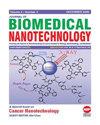Polyacrylic Acid-Modified Superparamagnetic Iron Oxide Nanoparticles Differentiate Between Hyperplastic and Metastatic Breast Cancer Lymph Nodes
IF 2.9
4区 医学
Q1 Medicine
引用次数: 0
Abstract
The recognition of lymph node (LN) metastasis is critical for breast cancer staging. Axillary lymph node (ALN) puncture or resection followed by biopsy, to determine whether the presence of metastasis is the diagnostic ‘gold standard’ for axillary lymph node metastasis. This procedure is an invasive procedure that triggers a series of complications. To solve this problem, we developed an ultrasmall superparamagnetic polyacrylic acid-modified iron oxide nanoparticles (PAA@IONs), which exhibit excellent physicochemical characteristics and are extremely stable in the aqueous state. They had an average hydrated particle size of 37.81±0.80 nm, average zeta potential of −38.7±3.8 mV, relaxivity R1 of 25.53±1.58 s−1mM−1, and R2 of 43.10±3.43 s−1mM−1. Animal magnetic resonance imaging (MRI) of the inflammatory hyperplasia model and tumor metastasis model of lymph nodes showed that the samples could effectively detect the metastasized tumors in lymph nodes (n =8). The inflammatory lymphadenopathy did not affect lymph node diagnosis, and this property helped overcome the challenge of current lymph node diagnosis, showing high sensitivity (100%) and specificity (83%). Body weight, hematology, coagulation parameters, serum biochemistry, gross anatomy, and histopathological examination of all Sprague-Dawley (SD) rats after intravenous administration of single or multiple doses of PAA@IONs showed no abnormal findings. Therefore, the ultrasmall superparamagnetic iron oxide nanoparticles constructed herein are a promising contrast agent for nodal tumor staging.聚丙烯酸改性超顺磁性氧化铁纳米粒子区分增生性和转移性乳腺癌淋巴结
淋巴结(LN)转移的识别是乳腺癌分期的关键。腋窝淋巴结(ALN)穿刺或切除后活检,以确定是否存在转移是诊断腋窝淋巴结转移的“金标准”。该手术是一种侵入性手术,会引发一系列并发症。为了解决这个问题,我们开发了一种超顺磁性聚丙烯酸修饰的超小氧化铁纳米颗粒(PAA@IONs),该纳米颗粒具有优异的物理化学特性,并且在水态下非常稳定。平均水合粒径为37.81±0.80 nm,平均zeta电位为- 38.7±3.8 mV,弛豫度R1为25.53±1.58 s−1mM−1,R2为43.10±3.43 s−1mM−1。淋巴结炎性增生模型和肿瘤转移模型的动物磁共振成像(MRI)显示,样品能有效检测淋巴结转移瘤(n =8)。炎性淋巴结病不影响淋巴结的诊断,这一特性克服了目前淋巴结诊断的挑战,具有很高的灵敏度(100%)和特异性(83%)。单次或多次静脉给药PAA@IONs后,所有SD大鼠的体重、血液学、凝血指标、血清生化、大体解剖和组织病理学检查均未见异常。因此,本文构建的超顺磁性氧化铁纳米颗粒是一种很有前途的淋巴结肿瘤分期造影剂。
本文章由计算机程序翻译,如有差异,请以英文原文为准。
求助全文
约1分钟内获得全文
求助全文
来源期刊
CiteScore
4.30
自引率
17.20%
发文量
145
审稿时长
2.3 months
期刊介绍:
Information not localized

 求助内容:
求助内容: 应助结果提醒方式:
应助结果提醒方式:


